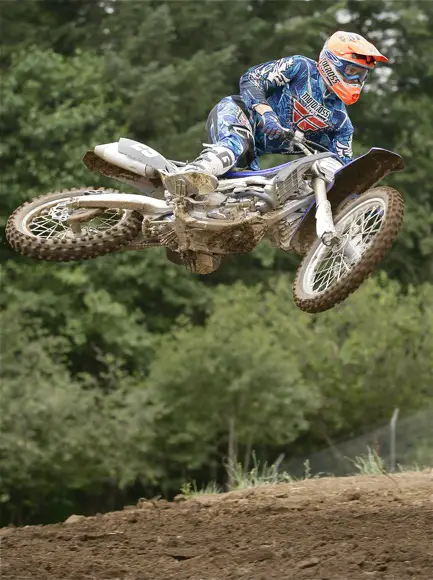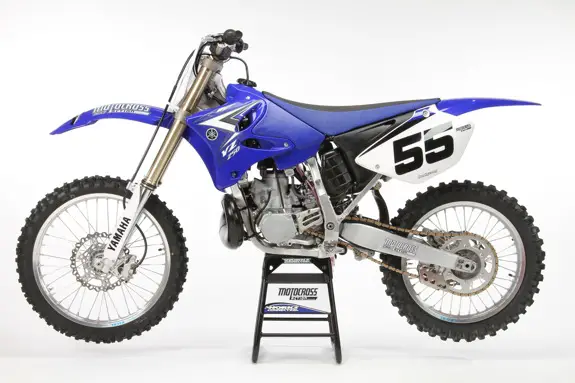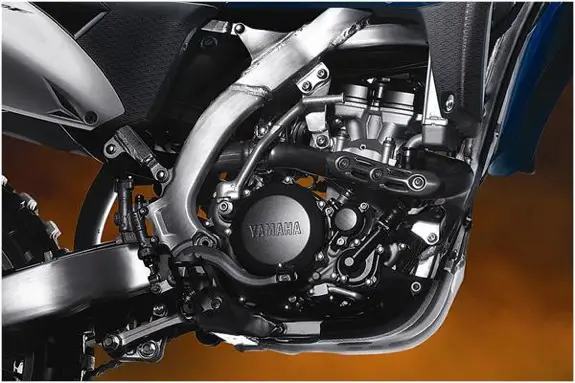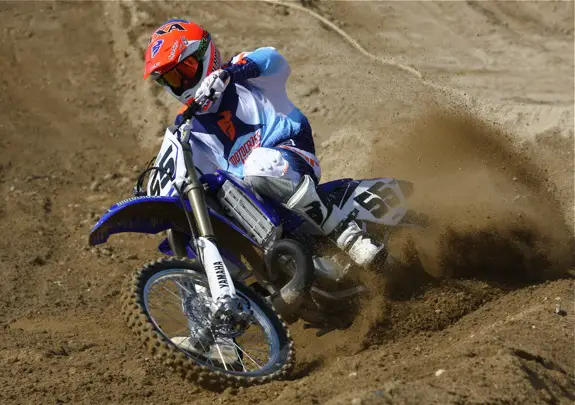YOU ASKED FOR IT! MOTOCROSS ACTION’S TWO-STROKE VERSUS FOUR-STROKE SHOOTOUT: YAMAHA YZ250 VERSUS YAMAHA YZ250F

The two-stroke versus four-stroke question comes up at regular intervals?so, we are rerunning our shootout to add clarity to the arguments.
Let’s cut through the effluvia! Rules changes made the four-stroke what it is today. It didn’t get there by virtue of its power per cubic centimeter, power per pound or power per dollar. Nope! Without the AMA four-stroke exemption rule of 1998, the modern four-stroke would still be defined by the Honda XR600. Forget about EPA rules (they don’t affect closed-course racing machines), fleet fuel averages (they don’t apply to offroad bikes), cost savings (four-strokes cost more to produce) or any of the other hokey reasons that the nattering nabobs of negativity credit the rise of the four-stroke on. None of those things are players. Engine for engine, cc for cc, ounce for ounce, the two-stroke motocross engine is a vastly superior piece of equipment. If the two-stroke was invented today, it would sweep the four-stroke motocross engine off the face of the earth (which is exactly what it did 43 years ago?when the displacement rules were equal). The only way a four-stroke can compete with a two-stroke is if the displacement is larger. The AMA four-stroke rule change was the impetus for the switch (followed by significant bike sales for the 1998 Yamaha YZ400–which led every other manufacturer to jump into building four-stroke motocross bikes).
No four-stroke displacement rule, no four-stroke motocross sales. No sales, no four-strokes.

A YZ250F four-stroke makes 20.1 foot-pounds of torque. Are you ready? A YZ250 two-stroke pumps out 30.6 ft-pounds.
The AMA rule forced 250cc two-strokes to compete against 450cc four-strokes. On paper it’s not that good a match, with both horsepower, torque and powerbands falling on the side of the thumper. Eventually, the factory race teams came to the realization, egged on the sales departments, that they needed to go all four-stroke, all the time.
The last competitive two-stroke 250cc rider on the AMA circuit was James Stewart. He was still winning motos, as late as 2006 on a KX250, but by the middle of the season he made the switch to four-strokes.

The YZ250F four-stroke never set the fastest time, but then it never set the slowest time either.
As it stands right now, only Yamaha and KTM still produce two-strokes for the masses (of the Big Five, although Husqvarna, TM and other boutique brands are still players). It is a little shocking that the AMA powers-that-be sat on their hands while the two-stroke died on the vine. Luckily, at amateur races, a 250cc stroke is legal to race in the same class as a 250cc four-stroke, but the two-stroke is not allowed to race against 250 four-strokes at the AMA Pro level. Most two-stroke fans would love to see a 250 class that was a true 250cc class (with four-strokes, two-strokes, diesels and Wankels on the line). It won’t happen because few in power want it to happen (even if they say that they do). Why not? Honda, Suzuki and Kawasaki don’t want it to happen. They don’t manufacture two-strokes for the American market and they don’t want Yamaha and KTM to show up at the 250 Nationals with YZ250 and 250SX bikes. When the subject was up for discussion a few years ago, it was reported that KTM said that if 250 two-strokes were made legal in the 250 class they promised not to put Tommy Searle on one. That butter didn’t lube the toast. And a 250cc displacement limit (regardless of engine type) has very little chance of ever being passed for AMA Pro racing. Thankfully, the amateur side has been more open-minded.
The MXA wrecking crew has tons of two- and four-stroke experience, so it was only natural that we would answer the question that every AMA Amateur is asking. What’s better? A YZ250 or YZ250F? We chose a Yamaha-versus-Yamaha comparison because that was the best way to eliminate any handling, suspension or component issues.

On tracks where horsepower paid big dividends, the fastest single lap time came on the YZ250 two-stroke.
Q: WHICH BIKE COSTS LESS?
A: In 2011 prices, the Yamaha YZ250 and YZ250F both retails for $7150. The YZ450F has a $8150 price tag. Surprised? We are. The YZ250 two-stroke should be retailing for around $6200 dollars (because that is what this design cost when it was first developed back in 2006. It is, after all, a seven-year-old bike. The YZ250F price is a thousand dollars cheaper than the 450 price. We must be paying extra for the backwards stuff.
Q: WHICH BIKE MAKES THE MOST NOISE?
A: No contest. If you are looking for an irritating sound that carries a long way, the four-stroke is the winner.
Q: WHAT’S THE DIFFERENCE BETWEEN THE YZ250 AND THE YZ250F?
A: The key difference between the YZ250 two-stroke and the YZ250F is the engine. The remainder of the changes are small set-up differences in spring rates, chassis strength and geometry. These changes stem from the fact that power output has a huge effect on how a bike handles, how the suspension works and what techniques the rider uses. The chassis must be compatible with the engine and the rider must synchronize with the capabilities of the bike.

At amateur races a 250cc stroke is legal to race in the same class as a 250cc four-stroke.
Q: WHICH BIKE MAKES THE MOST HORSEPOWER?
A: No comparison. A Yamaha YZ250F produces approximately 36 horsepower at 11,300 rpm, while a YZ250 two-stroke makes on average 46 horsepower at 8500 rpm. That is a ten horsepower advantage at peak for the two-stroke.
Q: WHICH BIKE MAKES THE MOST TORQUE?
A: Pit pundits will always tell you that horsepower doesn’t matter as much as torque. They wax on about the torque advantage that a four-stroke engine has over a two-stroke. Guess what? A Yamaha YZ250F four-stroke makes 20.1 foot-pounds of torque. Are you ready? A YZ250 two-stroke pumps out 30.6 ft-pounds. For comparison purposes a 450 four-strokes produces approximately 34 foot-pounds.

A Yamaha YZ250F produces approximately 36 horsepower at 11,300 rpm, while a YZ250 two-stroke makes on average 46.4 horsepower at 8500 rpm.
Q: WHICH BIKE HAS THE BEST POWERBAND?
A: Although the displacement of the two blue 250s is the same, the powerbands are apples and oranges. Here is a quick fruit pickers thumbnail of both bike’s powerbands:
YZ250 two-stroke: For a two-stroke the YZ250 has a very broad and usable powerband. But, by four-stroke standards, the power is peaky. The snappy throttle response and explosive hit allows a YZ250 racer to make cuts and take lines that a four-stroke could never get to. In some conditions the YZ250 two-stroke powerband is phenomenal. In others it has a tendency to spin the rear tire, wheelie out of corners and wiggle on the exit.
YZ250F four-stroke: In back-to-back races with the YZ250, the YZ250F engine feels slow. The hit is less pronounced (than the two-stroke), there is no wheelspin and the wiggle is reduced to a quiver. But, the feel of the YZ250F in comparison to the YZ250 is misleading. The lack of sensations of speed isn’t naturally followed up by a lack of speed. The powerband may be down ten horsepower, but it puts everything its got into the ground. It can be chugged. It can be lugged. And it can be revved until the cows comes home. The 13,000 rpm rev limiter and 11,300 rpm peak are about 3500 rpm higher and wider than the two-strokes working spread.
The choice: There is no doubt that the slower feeling, but broader and higher revving powerband of the YZ250F is easier to work with than the gun-and-run hit of the YZ250 two-stroke. It is easier to ride a four-stroke than a two-stroke?not more fun.

YZ250.
Q: WHICH ONE IS FASTER?
A: Going fast may not always be about sheer horsepower, but in perfect conditions horsepower will win out. In a straight line, the YZ250 two-stroke gets from one end of the line to the other end quicker. Much quicker.
But, all is not lost for the YZ250F. Motocross is not drag racing. It doesn’t take place on asphalt. There is no rubber-soaked launch pad at the start of every straight. There are certain conditions when the slower, but higher revving, YZ250F can actually go faster over a given distance than its two-stroke competitor.

The lap times are surprisingly, but understandable.
Q: WHICH BIKE PRODUCES THE BEST LAP TIMES?
A: Although MXA had a wide range of test riders spend time on both bikes, we left all lap time testing to a single test rider. We picked a 20-something Intermediate test rider because he was old enough to have raced a 250cc two-stroke and yet not immune to the charms of a four-stroke.
When we examined his lap times, taken from actual races not hot laps, we weren’t surprised to discover that his laps times on both the two-stroke and four-stroke were almost identical. Read that again. His lap times were identical regardless of which bike he was on. Depending on the track layout (hills, sand, whoops, jumps and hard pack) there were some deviations–but not enough to write home about.
On tracks where horsepower paid big dividends, the fastest single lap time came on the YZ250 two-stroke. But, on long tracks with harder dirt, the slowest lap time were also produced by the YZ250 two-stroke. Why? In the test rider’s opinion, the YZ250 two-stroke was more of a crap shoot to ride in that sometimes it was so brilliant out of berms and across rough ground that it seemed effortless, yet, the YZ250 two-stroke was also a lot easier to make mistakes on and those mistakes produced erratic lap times.
The YZ250F four-stroke never set the fastest time, but then it never set the slowest time either.
Across the board, if an MXA test rider could turn in a 2:35 on the YZ250, he could back it up with a 2:35 on the YZ250F in the next moto.

The YZ250F is at it’s best when the rider carries speed through the turns and flows around the track.
Q: WHAT CONDITIONS FAVOR EACH BIKE?
A: Slick conditions, where traction is limited and throttle control optimized, gives the YZ250F four-stroke the upper hand. The same held true in off-cambers and whoop sections with smallish humps. Every test rider believed that the steady throttle approach of the YZ250F four-stroke made the bike hook up better in tricky situations. Equally important for riders at tracks with concrete starting pads, the YZ250F could get off the line quicker. Unfortunately, the YZ250 two-stroke could uses its extra ponies to run it down if the start was long enough.
When the dirt was good, there was a lot of sand, the hills were steep and the whoops were big, the YZ250 two-stroke shined. The two-stroke literally exploded out of the soft corners that the YZ250F labored through. The tighter the turns and the deeper the dirt, the better the YZ250 was.
Q: WHICH ONE IS EASIER TO RIDE?
A: The YZ250F four-stroke was easier to ride. When the rider twisted the throttle of the YZ250F the power built smoothly. Four-stroke power is broad and forgiving, and since the bike can rev forever, the rider doesn’t have to worry as much about shift points.
A corollary to this is that a bike with less horsepower can be ridden closer to its full potential, while a powerful bike doesn’t always get taken to the limit?thus the extra horses often go to waste.

The two-stroke literally exploded out of the soft corners that the YZ250F labored through.
Q: WHICH ONE IS EASIER TO RACE?
A: We aren’t talking about riding in a field, cow trailing, practice riding or pretending to be racing?we are talking about actual racing against an angry pack of competitors. In these situations the YZ250 two-stroke can be put to full use. A YZ250 rider, especially if he is in the midst of a pack of 250cc four-strokes, has many options available to him (not to mention more power). He can go places where the four-strokes can’t. A two-stroke rider can dive bomb the inside, without fear of the long spool up that a four-stroke rider has to worry about. A two-stroke rider can bury the front into a berm and still break off at an extremely sharp angle.
Not so for the YZ250F rider. The YZ250F is at it’s best when the rider carries speed through the turns and flows around the track. This is fine for talented Intermediate and Pro riders, but Beginners and Novices tend to race to the corners more than through them. If the YZ250F gets its momentum broken, it takes time to get it steaming again. One truth about a conga line of four-strokes is that everyone is going to the exact same place?-there is an optimum four-stroke line and no one wants to get off it.
A two-stroke isn’t as tightly bound to the good line as a four-stroke. It can make cuts and with just a touch of the clutch be back up to speed. The explosive 250 two-stroke’s ability to make sharp turns and quick line changes make it a much more creative race bike. One caveat: If you don’t respect the explosive power of the two-stroke you’ll soon find yourself tumbling down the track like a monkey in a dryer.
Q: WHICH BIKE IS EASIER TO START?
A: The YZ250 wins this category. The YZ250F four-stroke requires a little less leg strength to turn the engine over. It likes a smooth kick of the full stroke of the kick lever. On a four-stroke you need to get the throttle setting just right. The YZ250 two-stroke doesn’t need a full kick and the moon and the stars don’t need to be properly aligned for it to fire. Hot or cold, whiskey throttle, after a crash, the two-stroke will almost always reignite. Not so with a four-stroke.

The complexity of the four-stroke engine makes it an expensive proposition to live with.
Q: WHICH BIKE HAS THE BEST HANDLING?
A: Both machines have their own distinct handling advantages?here is a quick snapshot of each:
YZ250 two-stroke: The snappy power of the two-stroke has more of a tendency to lift the front wheel, break traction and spin the rear tire. As a result, the bike turns from the rear. It likes to power slide and explode out of turns. In soft dirt and loam the two-stroke gets on top of the dirt much quicker than the YZ250F. It’s more willing make quick direction changes and switch lines on a whim. YZ250 two-stroke riders are rewarded for seeking out good dirt and taking the bull by the horns. Although the weight of the bikes is the same, the power delivery of the two-stroke makes it feel lighter.
YZ250F four-stroke: The YZ250F mill only produces power every other revolution. This produces a smooth torque curve that drives the bike forward with much more weight on the front wheel. The YZ250F is a front-wheel handler that likes to be steered around turns. The power doesn’t come on quickly, it builds over time. It’s more prone to coming out of corners like a road racer. YZ250F riders are rewarded by planning ahead, making nice arcing turns and carrying speed. The YZ250F is much more planted to the ground and when the rider makes mistakes things happen a bit slower.
Q: WHICH BIKE HAS THE BEST SUSPENSION?
A: The YZ250. The suspension components of each bike are identical?-except for their differing setups. However, the different powerbands work the suspension a bit differently. The quicker power of the two-stroke is more likely to put a spiking load on the rear suspension under acceleration and the lack of engine compression allows it to enter bumpy corners without a lot of wheel hop. Logic dictates that the setup for the same rider would have a bit more high-speed compression and a bit quicker rebound in the rear of the two-stroke.

YZ250F.
Q: WHICH BIKE IS EASIER TO MAINTAIN?
A: The YZ250 two-stroke naturally goes through tires, brakes pads, chains and sprockets a bit faster because it makes more power. But the complexity of the YZ250F four-stroke engine makes it an expensive proposition to live with also. And, even a mechanic with four thumbs can work on and rebuild a two-stroke at home (in the kitchen)?not so with a four-stroke. The ability to do your own engine work is one of the highlights of a two-stroke. It is a simple machine, with very few moving parts, and that fact makes it cheaper in the long run than a complex four-stroke with ten times the number of moving parts.
Q: WHAT ABOUT ENGINE REBUILDS?
A: Puhleeze! Two-stroke engines are a easier to rebuild, have less parts and the parts cost less. That recipe means that you could rebuild a YZ250 three or four times for the cost of one rebuild on the YZ250F. It should be noted that a four-stroke is very much like a maintenance-free battery?it cost absolutely nothing as long as it keeps running. In this fashion, a YZ250F four-stroke may be cheaper when it comes to pistons, rings and rebuilds?as long as it doesn’t blow. However, don’t even think about the cost of a catastrophic failure on a four-stroke engine.

For a racer, starting on a typical dirt starting line, the YZ250 two-stroke should always get the holeshot.
Q: WHAT’S THE FINAL WORD?
A: The MXA wrecking crew doesn’t want you to run out and buy a bike just because we think it is the winner. We want you to look at the strengths and weaknesses of the YZ250 and YZ250F (or any two-versus-four match-up) and add that to your personal strengths and weaknesses.
Logic says that since lap times are virtually identical for the same rider on both bikes, that the real difference comes down to the battle of ten horsepower over an easier-to-ride chassis. For a racer, starting on a typical dirt starting line, the YZ250 two-stroke should always get the holeshot. If the 250cc two-stroke doesn’t beat a 250cc four-stroke to the first turn, the rider should retire and take up mushroom farming. The YZ250F four-stroke should never be able to overcome the ten horsepower disadvantage in the first 200 feet. From that point on, it’s a matter of whether the track has the kind of conditions that will force the two-stroke rider into making a mistake. If he doesn’t, he will keep the lead to the checkered flag.
Does that means that the starting gates are going to fill up with YZ250 two-stroke riders? No. The average 250 Novice or Intermediate has no 250cc two-stroke experience and it will cost him the price of a YZ250 two-stroke to gain that know-how. For most riders, with average talent, the difference won’t be worth the extra cost. The 250 two-stroke is a superior machine in most ways, but that superiority has to be perceived and acted on in a crowd full of valve-and-cam sheep.
MXA doesn’t believe at the AMA Pro level that changing the rule that currently bans 250 two-strokes from racing in the 250 West and 250 Nationals would lead to a flood of two-strokes running away from the 250 four-strokes. The modern racing four-stroke has a five-year development advantage over the older two-strokes. Additionally, Pro Circuit, Geico, Honda, Yamaha, Suzuki and Kawasaki would keep their high-paid riders on their racing four-strokes. The real advantage of allowing 250 two-strokes in the 250 four-stroke class, would be fourfold:
(1) Privateers could compete at a higher level for a lower cost. Even at the National level, engine mods on a two-stroke top out at around $1000?you can’t buy the top-end parts for a four-stroke for that amount.
(2) When you mix two-strokes with four-strokes on a race track you get an interesting mix of lines, sounds and styles. The fans could, and would, root for various riders based solely on the rider’s choice of engine type. The mix would add another dimension to the races that isn’t there now.
(3) If AMA Pros raced two-strokes then local racers would be more willing to race them also. Why? Because sales are the only reason that factories even race motorcycles. Pro racers are a sales tool?thus having Pros on two-strokes would get them credibility. The number of manufacturers who might enter AMA racing, who don’t because of the might of the Japanese four-stroke development programs, would hopefully increase. Not counting KTM and Yamaha, Husqvarna and TM are potential factories that might be willing to race in the 250 class if two-strokes were legalized.
(4) Since the AMA handed the four-stroke a major displacement advantage with the stroke of a pen (an advantage so major that it made the two-stroke uncompetitive), it is only right that the advantage be taken away with the stroke of a pen. Of course the sanctioning bodies are afraid of what the Big Four will say if they change this rule, but if something isn’t done to increase the excitement level, lower the start-up costs, decrease the maintenance and produce simple machines that the next generation can work on in the garage?there may not be a next generation or a Big Four. Two-strokes cannot fix the American motocross market, but the death of them (or was it actually a murder) did a lot to get it in its current doldrums.






Comments are closed.